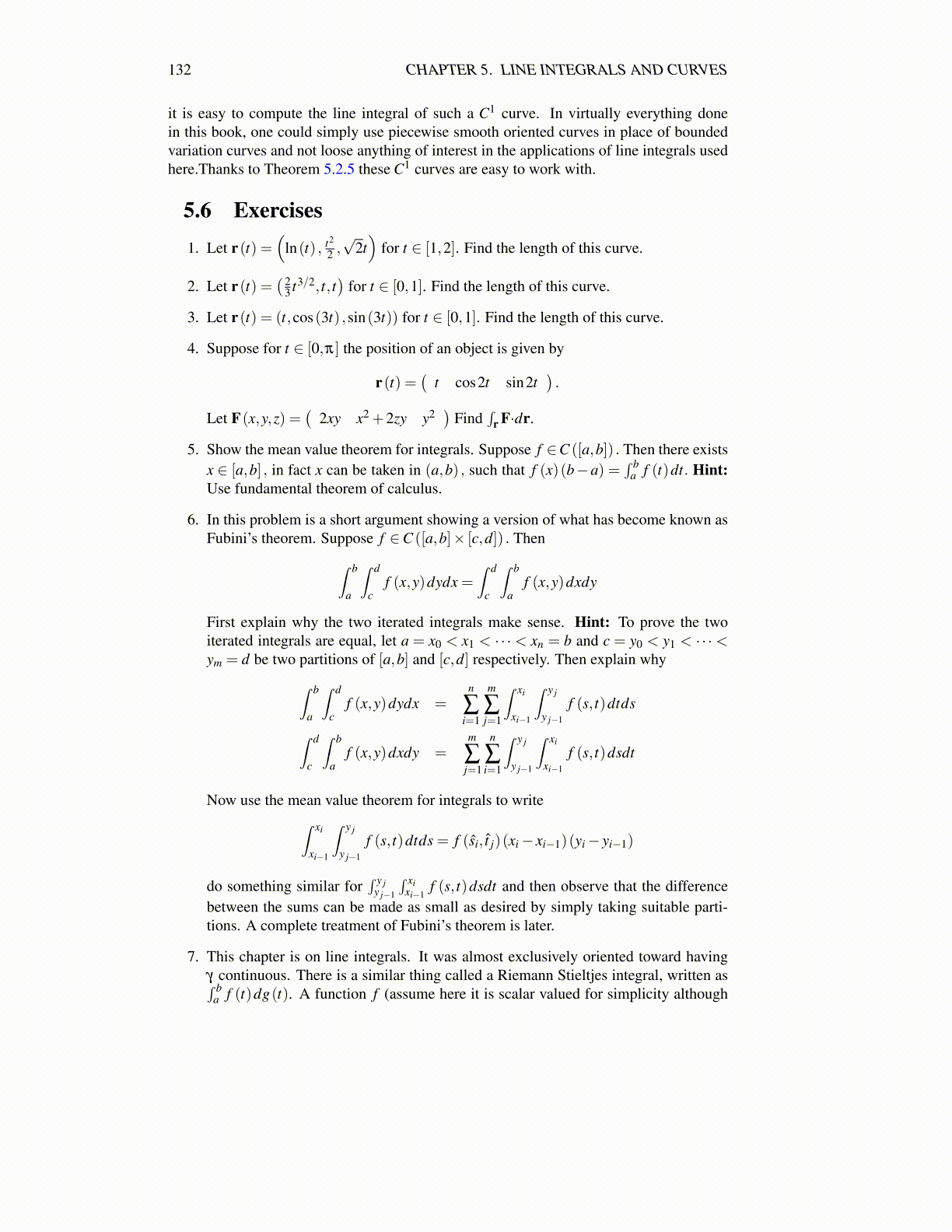
132 CHAPTER 5. LINE INTEGRALS AND CURVES
it is easy to compute the line integral of such a C1 curve. In virtually everything donein this book, one could simply use piecewise smooth oriented curves in place of boundedvariation curves and not loose anything of interest in the applications of line integrals usedhere.Thanks to Theorem 5.2.5 these C1 curves are easy to work with.
5.6 Exercises1. Let r(t) =
(ln(t) , t2
2 ,√
2t)
for t ∈ [1,2]. Find the length of this curve.
2. Let r(t) =( 2
3 t3/2, t, t)
for t ∈ [0,1]. Find the length of this curve.
3. Let r(t) = (t,cos(3t) ,sin(3t)) for t ∈ [0,1]. Find the length of this curve.
4. Suppose for t ∈ [0,π] the position of an object is given by
r(t) =(
t cos2t sin2t).
Let F(x,y,z) =(
2xy x2 +2zy y2)
Find∫
r F·dr.
5. Show the mean value theorem for integrals. Suppose f ∈C ([a,b]) . Then there existsx ∈ [a,b] , in fact x can be taken in (a,b) , such that f (x)(b−a) =
∫ ba f (t)dt. Hint:
Use fundamental theorem of calculus.
6. In this problem is a short argument showing a version of what has become known asFubini’s theorem. Suppose f ∈C ([a,b]× [c,d]) . Then∫ b
a
∫ d
cf (x,y)dydx =
∫ d
c
∫ b
af (x,y)dxdy
First explain why the two iterated integrals make sense. Hint: To prove the twoiterated integrals are equal, let a = x0 < x1 < · · · < xn = b and c = y0 < y1 < · · · <ym = d be two partitions of [a,b] and [c,d] respectively. Then explain why∫ b
a
∫ d
cf (x,y)dydx =
n
∑i=1
m
∑j=1
∫ xi
xi−1
∫ y j
y j−1
f (s, t)dtds
∫ d
c
∫ b
af (x,y)dxdy =
m
∑j=1
n
∑i=1
∫ y j
y j−1
∫ xi
xi−1
f (s, t)dsdt
Now use the mean value theorem for integrals to write∫ xi
xi−1
∫ y j
y j−1
f (s, t)dtds = f (ŝi, t̂ j)(xi− xi−1)(yi− yi−1)
do something similar for∫ y j
y j−1
∫ xixi−1
f (s, t)dsdt and then observe that the differencebetween the sums can be made as small as desired by simply taking suitable parti-tions. A complete treatment of Fubini’s theorem is later.
7. This chapter is on line integrals. It was almost exclusively oriented toward havingγ continuous. There is a similar thing called a Riemann Stieltjes integral, written as∫ b
a f (t)dg(t). A function f (assume here it is scalar valued for simplicity although